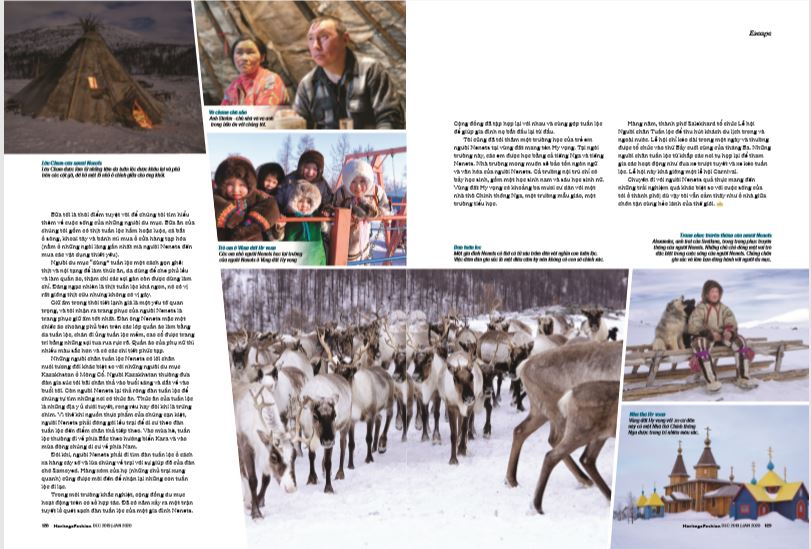Maxby’s article, the Reindeer Herders of the Arctic Tundra was featured in the December 2020 issue of Heritage Fashion Magazine. Heritage Fashion Magazine is the in-flight magazine of the Vietnam Airlines. You can visit Vietnam Airlines website: https://www.vietnamairlines.com/au/en/home

REINDEER HERDERS OF THE ARCTIC TUNDRA
What do beautiful winter-scapes, arctic tundra, aurora borealis, nomads, and reindeer, have in common?
I have always harbored a life-long desire to travel to ‘dream places’ that are off the beaten track. This is to gain an insight into how people all over the world live in various physical and environmental conditions and sharing it with others.
In March 2019, I embarked on an adventure to visit the Nenets at Yamal Peninsula, a nomadic tribe whose main livelihood is to herd reindeers. Presently there are about 30,000 Nenets according to the 2010 Russian Census.
Yamal means the end of the world; so yes it is remote and a land of permafrost, frigid, harsh and unforgiving weather which can hit -50°C.
When I first sighted the Nenets camp, I was greeted by small barking dogs, and several teepee shaped tents called chums. The chums looked far larger than I had expected, perhaps five to six meters in diameter, supported by many strong wooden poles and was completely covered by multiple layers of reindeer skins. At the center of the chum is a metal multipurpose wood-fired oven both for cooking and heating. Sleeping, cooking, and eating are all done inside the chums.
Our hosts Stefan and his wife, Svetlana together with his closest relatives welcomed us to their home and life with open arms. Svetlana took excellent care of us and did all the cooking, cleaning and sewing as well as caring of any sick or orphaned reindeer, whilst the men handle the reindeer herd including watching out for natural predators like wolverines, polar bears, grey wolves, chopping of firewood, and repairing of sledges, etc.
Electricity supply is through a power generator, and water is from melting snow. Nomads only bathe in summer normally, and nature is where you go to answer the call of nature!
Dinner times were wonderful sharing opportunities for us to find out more about their lives. Our meals were basically made up of stewed or boiled reindeer meat, fish caught from rivers, and potatoes and bread bought from grocery stores when they go to the nearest village for essential supplies. All parts of the reindeer are used; meat and organs are eaten, the hide is used for the covering for the chums and for clothing, even the tendons for threads. I found the reindeer meat to be surprisingly good and tasted very much like mutton without the gamey smell and taste. When a reindeer is slaughtered for food, the warm blood is drunk right away. Luckily, I was spared from this experience.
Keeping warm in the frigid cold is a key factor, and I reckon that the Nenets outfits are the warmest amongst all modern winter wear. The men wear a plain poncho-like top over layers of reindeer skin clothing, with long soft reindeer boots with brightly decorated tassels. I noticed the women’s clothing were much more colorful with intricate details. These beautiful traditional hand-sewn clothing are worn proudly to reflect their unique heritage.
Stefan told us that the reindeer antlers are harvested around July/August and sold mostly to Chinese buyers who have been using reindeer antlers for traditional medicinal purposes for over 2000 years. These can fetch up to USD50/kg, and a whole reindeer for USD400 each.
The Nenets reindeer herders are rather different from the Kazakh nomads in Mongolia. Whilst the Kazakhs drive their herds to grazing grounds in the morning and then herd back in the evening, the Nenets leave their herds to graze wherever the reindeers find food. Reindeers live on lichens found under the layer of snow, moss and sometimes birds eggs, so when the food supply is exhausted, the Nenets have to pack up their camps and follow the reindeer to its next grazing grounds. In summer, the reindeer migrate to the north towards the Kara Sea and in winter, and in summer it heads southwards.
Sometimes, the Nenets would round up their reindeer herd kilometers away and drive them back to the camp for inspection with the help of their Samoyed dogs. Neighbors are invited to come and identify the reindeer that may belong to them as reindeer from different herds often get mixed up so this is the time for the different herd owners to claim their own.
This nomadic community practices mutual cooperation for survival in this harsh environment. There was an avalanche that occurred one year which wiped out the herd of a Nenets family. The community rallied around with the contribution of some reindeer to help the distressed family get started again.
I visited a Nenets school for the Nenets’ children at the Land of Hope. This school teaches in both Russian and Nenets languages. The school hopes to preserve the Nenets language and culture. There are only seven students at this moment in the boarding school of which six are girls and a boy. The Land of Hope has about thirty residents with an Orthodox Church, kindergarten, a school, and living quarters.
The city of Salekhard has organized an annual Reindeer Herders Festival to draw in both local and foreign tourists. The festival lasts only for a day and is usually held on the last Saturday of March. Reindeer Herders from around the region come together to compete in various events like the snowmobile and reindeer sledge racing. I find that this festival is more like a carnival.
The lifestyle of nomads and city dwellers are far apart and yet each and everyone would rather live in their own comfort zone when given a choice.
How do you get there? Vietnam Air flies regularly to Moscow. From Moscow, take an internal flight to Salekhard.







